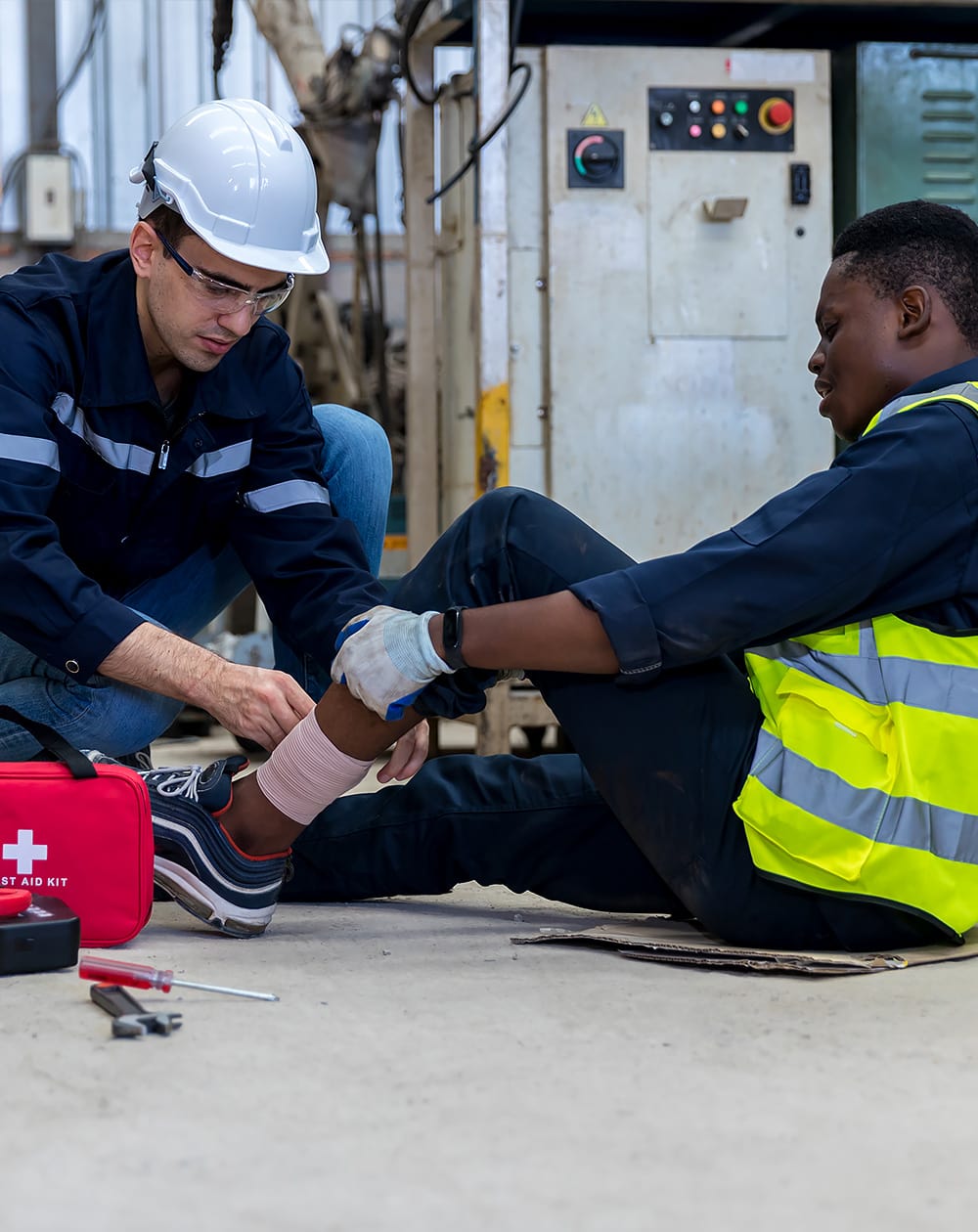Our ankles provide support and stability to our bodies, allowing us to be balanced and mobile when on our feet. However, when someone injures their ankle, it could make the simplest tasks significantly more difficult. It could also limit their ability to perform their work duties, potentially diminishing their income. When someone suffers an ankle injury at work, they may be entitled to workers’ compensation benefits through their employer to help cover medical expenses, lost wages, and more.
When you injure your ankle on the job, you need the care of an experienced work injury doctor who will help secure your return to work. At Spine and Joint Institute of Milwaukee, this is what we do best. Our clinic will thoroughly examine your ankle injury and develop a comprehensive treatment plan to ensure a complete recovery to get you back on track. Our medical professionals are also well-versed in the workers’ compensation claims process. They will precisely document your injury and treatment, helping you and your workers’ compensation attorney build your strongest case.

Common causes of ankle injuries at work can include:
The extent to which you can heal from an ankle injury depends on several factors, including the severity of the injury, the type of treatment received, and individual factors such as age and overall health. In many cases, with proper treatment and rehabilitation, people can fully recover from ankle injuries. Here are some common types of ankle injuries and their typical recovery times:
Ligament injuries happen when the tough bands of tissue connecting bones at a joint are stretched, torn, or damaged due to sudden twists, impacts, overuse, or repetitive stress. These injuries can range from mild sprains to severe tears, resulting in pain, swelling, instability, and limited mobility in the affected joint. Treatment can involve rest, ice, compression, elevation, physical therapy, bracing, and sometimes surgery for severe cases. Proper rehabilitation is crucial for regaining strength, flexibility, and stability in the joint and preventing future injuries.
Injuries to the tendons surrounding the ankle, such as Achilles tendonitis or peroneal tendon injuries, can require rest, physical therapy, and sometimes immobilization or surgery. Recovery time can vary depending on the extent of the tendon damage and the effectiveness of treatment, but many people can achieve full recovery with proper care.
Damage to the cartilage within the ankle joint, such as osteochondral lesions or cartilage tears, may require surgical intervention and rehabilitation to achieve complete healing. Recovery from cartilage injuries can be more complex. It may take several months to a year or longer, depending on the injury's severity and the treatment's success.
Ankle fractures can range from minor hairline fractures to more severe breaks that require surgery. The recovery time for fractures can vary significantly depending on the type and severity of the fracture and the treatment approach. Minor fractures may heal within a few weeks with immobilization and physical therapy, while more severe fractures may take several months to heal completely.
It's important to follow your healthcare provider's recommendations for treatment and rehabilitation to optimize your chances of a full recovery. In some cases, particularly with more severe injuries, there may be lingering symptoms or limitations even after healing is complete. Additionally, taking steps to prevent future injuries, such as strengthening exercises, proper footwear, and avoiding risky activities, can help protect your ankles in the long term.

If you've injured your ankle at work, taking immediate steps to ensure proper care and recovery is essential. Everyone's recovery process from an injured ankle differs, so be patient with yourself and give your body the time it needs to heal properly. Here's what you should do:
If the injury is severe, seek immediate medical attention. If the ankle injury is minor, ensure it receives proper first aid. Elevate the ankle if possible and apply ice to reduce swelling.
Inform your supervisor or HR department about the injury as soon as possible. This is important for documentation of the ankle injury and to initiate any necessary workers' compensation claims.
If you've seen a doctor for your ankle injury, follow their instructions carefully. This may include using crutches, wearing a brace, or keeping weight off the injured ankle.
Rest is crucial for healing. Keep your ankle elevated whenever possible to reduce swelling. Avoid putting weight on it unless advised otherwise by a healthcare professional.
Apply ice packs to the injured area for 15-20 minutes every few hours to reduce swelling. Compression bandages can also help stabilize the ankle and reduce swelling.
Over-the-counter pain relievers such as ibuprofen or acetaminophen can help manage pain and inflammation. Follow the dosage instructions on the packaging.
Depending on the severity of the injury, your doctor may recommend physical therapy to help regain strength and flexibility in your ankle.
While resting is necessary, try to stay as active as possible without putting strain on your injured ankle. This could involve gentle exercises recommended by your doctor or engaging in activities that don't aggravate the injury.
Attend any follow-up appointments with your doctor to monitor your progress and adjust your treatment plan if necessary.
Keep your employer informed about your progress and any limitations you may have while recovering. This will help them make any necessary accommodations to support your return to work when you're ready.
In the state of Wisconsin under Worker's Compensation Law, Statute 102.42(2)(a) of the Worker's Compensation Act, you are allowed to choose your own healthcare provider, and states in part, “…the employer shall offer to the injured employee his or her choice of any physician, chiropractor, psychologist, dentist, physician assistant, advanced nurse prescriber, or podiatrist licensed to practice…”
Common treatments for work-related ankle injuries typically involve a combination of therapies and, in some cases, more advanced medical interventions. The specific treatment approach will depend on the nature and severity of the ankle injury and individual factors such as age, overall health, and job requirements. Individuals with a work-related ankle injury need to follow their healthcare provider's recommendations for treatment and rehabilitation to optimize recovery and minimize the risk of recurrence. Here are some common treatments:
Resting the injured ankle is crucial to allow the tissues to heal correctly. This may involve reducing or avoiding weight-bearing activities for some time.
Applying ice to the injured ankle can help reduce pain, swelling, and inflammation. Using ice for 15-20 minutes every 2-3 hours during the first two days following the injury is generally recommended.
Wrapping the ankle with an elastic bandage or wearing a compression sleeve can help reduce swelling and support the injured area.
Elevating the injured ankle above the level of the heart can help reduce swelling by promoting fluid drainage from the injured tissues.
Over-the-counter pain medications, such as ibuprofen or acetaminophen, can help alleviate ankle pain and discomfort associated with the injury.
Physical therapy exercises and modalities can help improve strength, flexibility, and range of motion in the ankle joint, promote proper healing, and prevent future injuries.
In some cases, wearing a brace, splint, or walking boot may be necessary to immobilize the ankle and allow it to heal properly, especially for more severe injuries or fractures.
Once the acute healing phase has passed, specific rehabilitation exercises can help restore the ankle joint's function and stability.
Occupational therapy may be recommended to assist with a safe return to work, including ergonomic assessments, job modification, and functional rehabilitation.
In cases of severe ankle injuries, such as fractures or ligament tears that do not respond to conservative treatment, surgery may be necessary to repair the damage and restore stability to the ankle joint.
Common types of ankle injuries that can occur in the workplace include:
Fractured Ankle. A fracture or break in one or more bones that make up the ankle joint can occur due to a fall, impact, or other trauma.
Achilles Tendon Rupture. The Achilles tendon, which connects the calf muscles to the heel bone, can tear or rupture, often due to sudden force or overuse.
Tendonitis. Inflammation of the tendons around the ankle, such as the Achilles tendon or the peroneal tendons, can result from overuse, repetitive motion, or sudden injury.
Ankle Contusions. The ankle bones or soft tissues can bruise due to impact or trauma, such as being hit by a falling object or bumping into equipment.
Ankle Strains. Like sprains, strains involve stretching or tearing muscles or tendons around the ankle joint. They can result from overstretching, overuse, or sudden twisting movements.
Ankle Dislocation. This occurs when the ankle joint bones are forced out of their normal position, often due to a severe impact or twisting injury.
Tarsal Tunnel Syndrome. Compression or irritation of the tibial nerve as it passes through the tarsal tunnel (a narrow space on the inside of the ankle) can lead to pain, numbness, and tingling in the ankle and foot.
These injuries can occur in various workplace settings, including offices, construction sites, factories, warehouses, and healthcare facilities. Preventive measures such as proper training, appropriate footwear, maintaining a clean and safe work environment, and implementing ergonomic practices can help reduce the risk of ankle injuries in the workplace.
At Spine and Joint Institute of Milwaukee, our compassionate medical professionals care deeply about your health and well-being, and your recovery is our priority. We stand ready to provide the comprehensive treatment you need while helping build a strong workers’ compensation case for your attorney, in order to secure your return to work.
If you or a loved one has experienced an ankle injury, contact Spine and Joint Institute of Milwaukee right away. Our team is here to provide the support and care you need to navigate the challenges of work-related injury recovery while documenting your treatment properly for your workers’ compensation claim. We work closely with our patients and help ensure a swift recovery, a stress-free workers' compensation claims process, and a safe return to work.

If you are not receiving proper care for your injury, you have the right under Wisconsin Workers' Compensation Law to choose your own doctor and to get a second opinion.